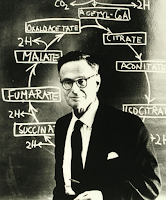Decoding Krebs Cycle II: Completing the Cycle

... One of the metabolic processes is called citric acid cycle (CAC) or famously known as Krebs cycle; named after its discoverer Hans Krebs. Hans Krebs himself was awarded Nobel Prize in Physiology or Medicine in 1953... In part I, we decoded half of the Krebs cycle as citrate ion (6C) is converted to succinyl-CoA (4C) after several steps. Afterwards, in succinyl coenzyme synthetase (CSC) succinate (4C) is formed from succinyl-CoA (4C) with helps of either GDP or ADP.




